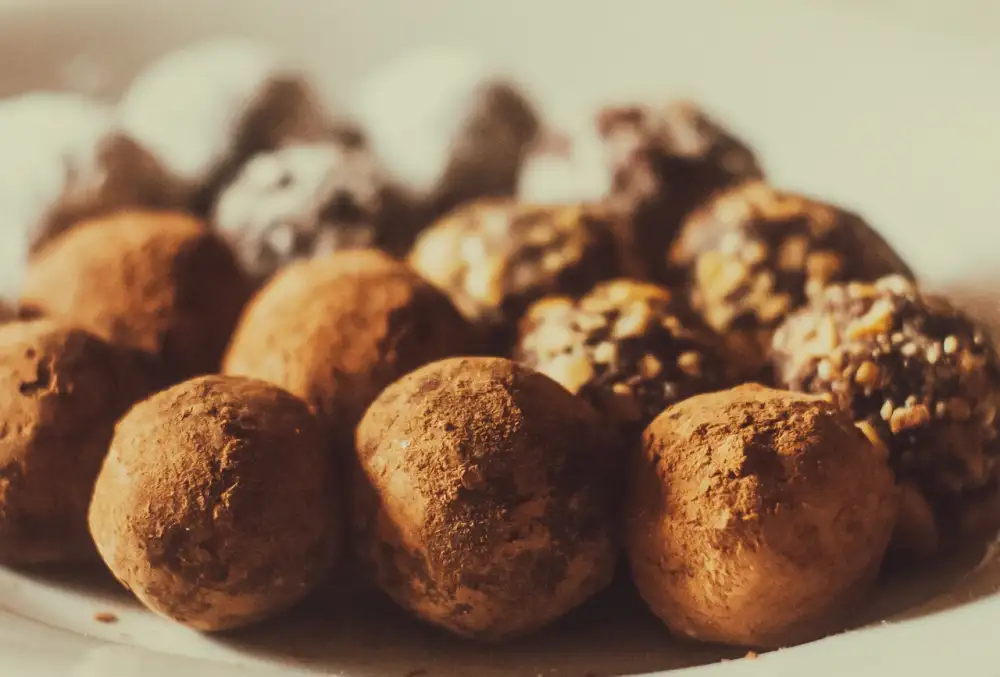Unveiling the Mystery: What is a Truffle? A Delectable Guide to this Culinary Delight

Truffles, often referred to as the "diamonds of the kitchen," are a highly prized and sought-after culinary delicacy. These unique fungi have captivated the palates of food enthusiasts for centuries with their intense aroma and exquisite flavor. Whether enjoyed shaved over pasta, infused into oils, or incorporated into gourmet dishes, truffles add an unparalleled depth and complexity to any meal. Join us on a delectable journey as we explore the fascinating world of truffles and uncover the secrets behind their allure.
Definition and Origin of Truffles
Truffles are a highly prized and sought-after culinary delicacy, known for their unique and intense flavor. But what exactly are truffles? Truffles are a type of edible fungus that grows underground in symbiotic association with the roots of certain trees, such as oak, hazel, and beech. They belong to the Tuber genus and are part of the Ascomycota division of fungi.
Originating from Europe, truffles have been enjoyed for centuries and were even considered a luxury food by ancient civilizations like the Greeks and Romans. The first recorded use of truffles dates back to ancient Egypt, where they were used as an ingredient in cooking and believed to have medicinal properties.
Truffles can be found in various regions around the world, including France, Italy, Spain, Croatia, and even parts of North America. However, it is worth noting that not all truffles are created equal. The most highly prized and expensive truffles come from specific regions in France and Italy.
The unique aroma and flavor of truffles have made them a favorite among chefs and food enthusiasts alike. Their distinct earthy taste is often described as nutty or musky with hints of garlic or shallots. Truffle oil or shavings can elevate any dish to new heights by adding depth and complexity.
In conclusion, truffles are a type of underground fungus that grow in association with certain tree roots. They have a rich history dating back thousands of years and are highly valued for their unique flavor profile. With their origin rooted in Europe but now cultivated in various parts of the world, truffles continue to captivate our taste buds with their exquisite taste.
Types of Truffles
Truffles come in various types, each with its own distinct flavor and aroma. The two most common types are black truffles (Tuber melanosporum) and white truffles (Tuber magnatum). Black truffles are known for their strong, earthy flavor, while white truffles have a more delicate and pungent aroma.
Another popular type is the summer truffle (Tuber aestivum), which is harvested during the warmer months. It has a milder taste compared to black and white truffles but still adds a unique flavor to dishes. Burgundy truffles (Tuber uncinatum) are similar to black truffles but have a slightly different taste profile.
There are also lesser-known varieties such as the Alba truffle (Tuber magnatum pico), which is considered one of the most prized and expensive truffles in the world. Other types include the Chinese truffle (Tuber indicum) and the Oregon black truffle (Leucangium carthusianum).
Each type of truffle has its own distinct characteristics, making them sought after by chefs and food enthusiasts alike. Their unique flavors add depth and complexity to a wide range of dishes, making them an exquisite culinary delight.
Characteristics and Appearance of Truffles
Truffles are renowned for their unique characteristics and distinctive appearance. These prized fungi have a rough, irregular shape, resembling small lumps or knobs. Their size can range from that of a marble to that of a potato, depending on the species.
The outer skin of truffles is usually dark brown or black, with a rough texture that resembles the bark of a tree. It is this outer layer that protects the delicate flesh inside. Some truffle varieties may have lighter-colored veins running through the exterior, adding to their visual appeal.
When cut open, truffles reveal a marbled interior with intricate patterns of white or cream-colored veins. The flesh is firm yet tender, and it emits an intense aroma that is often described as earthy, musky, or even garlicky.
Truffles are known for their strong fragrance, which permeates the air around them. This aroma plays a crucial role in attracting animals like pigs and dogs during truffle hunting expeditions.
It is worth noting that not all truffles possess the same appearance or aroma. Different species and varieties exhibit variations in color, size, and scent profiles. Each type of truffle has its own distinct characteristics, making them highly sought after by chefs and food enthusiasts worldwide.
Overall, the characteristics and appearance of truffles contribute to their allure as one of the most coveted culinary delicacies in the world.
Culinary Uses of Truffles
Truffles are highly prized in the culinary world for their unique and intense flavor. Their distinct aroma and earthy taste make them a sought-after ingredient in gourmet cuisine. Truffles are often used sparingly due to their high cost, as they are considered a luxury item.
One of the most popular ways to enjoy truffles is by shaving them over dishes such as pasta, risotto, or scrambled eggs. The thin slices of truffle add a rich and indulgent flavor that elevates the dish to new heights. Truffle oil is also widely used to infuse dishes with its intense flavor, although it is important to note that not all truffle oils contain real truffle extract.
Truffles can be incorporated into various sauces and spreads, enhancing their taste profile. They can be finely chopped and added to butter or cream-based sauces, creating a decadent accompaniment for meats or vegetables. Truffle-infused honey or salt is another popular way to incorporate this delicacy into sweet or savory dishes.
Chefs also experiment with truffles in desserts, adding a surprising twist to traditional sweets. Truffle-flavored chocolates or ice creams offer a unique combination of flavors that intrigue the palate.
It is crucial to handle truffles with care when cooking with them since heat can diminish their delicate flavors. Therefore, it is recommended to add truffles towards the end of cooking or use them raw.
Overall, truffles have become synonymous with luxury dining due to their exquisite taste and rarity. Their culinary uses are diverse and provide an opportunity for chefs and home cooks alike to create extraordinary dishes that delight the senses.
Truffle Hunting and Cultivation
Truffle hunting is an age-old practice that involves the search for these elusive delicacies in their natural habitat. Trained dogs or pigs are often used to sniff out the distinct aroma emitted by truffles, as they grow underground near the roots of certain trees.
The process of cultivating truffles, known as trufficulture, has gained popularity in recent years due to the high demand for these gourmet treasures. It involves planting specific tree species, such as oak or hazelnut, with truffle spores in their root systems. These spores develop into mycelium, which forms a symbiotic relationship with the tree roots.
Cultivating truffles requires patience and expertise, as it can take several years for the first harvest to occur. The success of trufficulture depends on various factors including soil quality, climate conditions, and proper maintenance of the truffle orchard.
Truffle hunters and cultivators often keep their methods closely guarded secrets. They venture into forests and carefully observe signs like changes in soil composition or presence of specific tree species to identify potential truffle habitats. This traditional method adds an element of excitement and mystery to the process.
With advancements in technology and scientific research, there have been significant developments in artificial cultivation techniques. These methods aim to replicate the natural conditions required for truffle growth and reduce the time it takes for a harvest.
Truffle hunting and cultivation not only contribute to the preservation of this culinary treasure but also support local economies in regions where truffles are found. It is a delicate balance between preserving nature's secrets while satisfying our desire for this exquisite delicacy.
Health Benefits of Truffles
Truffles are not only a culinary delight but also offer several health benefits. These underground fungi are packed with nutrients and contain a variety of compounds that can promote overall well-being.
Firstly, truffles are rich in antioxidants, which help protect the body against harmful free radicals and reduce the risk of chronic diseases like heart disease and cancer. They also contain vitamins C and E, which further enhance their antioxidant properties.
Additionally, truffles are a good source of minerals such as potassium, magnesium, and iron. Potassium helps regulate blood pressure and maintain proper heart function, while magnesium supports bone health and aids in muscle relaxation. Iron is essential for the production of red blood cells and oxygen transport throughout the body.
Moreover, truffles are known to have antimicrobial properties due to their content of compounds like phenols and flavonoids. These properties can help fight off harmful bacteria and viruses, boosting the immune system.
Furthermore, truffles are low in calories and fat while being high in fiber. This makes them a suitable addition to a balanced diet for those looking to manage their weight or improve digestion.
It is important to note that truffle consumption should be moderate due to their high purine content. Excessive intake may lead to increased uric acid levels in the body, potentially causing gout flare-ups in susceptible individuals.
In conclusion, apart from their exquisite taste, truffles offer numerous health benefits. From their antioxidant properties to their mineral content and antimicrobial effects, incorporating truffles into your diet can contribute positively to your overall well-being. However, it is always advisable to enjoy them in moderation as part of a varied and balanced diet.
Popular Truffle Recipes
Truffles, with their unique and intense flavor, have become a prized ingredient in many gourmet dishes. Here are some popular recipes that showcase the exquisite taste of truffles:
1. Truffle Risotto: A classic Italian dish, truffle risotto combines the creamy richness of Arborio rice with the earthy flavors of truffles. The truffle shavings are added at the end to enhance the dish's aroma and taste.
2. Truffle Pasta: Simple yet elegant, truffle pasta is a favorite among food enthusiasts. Toss freshly cooked pasta with butter, Parmesan cheese, and generous amounts of grated truffles for a decadent meal.
3. Truffle Oil Dressing: Create a luxurious salad dressing by combining truffle oil with balsamic vinegar, Dijon mustard, and honey. Drizzle this aromatic dressing over mixed greens or roasted vegetables for a delightful twist.
4. Truffled Scrambled Eggs: Elevate your breakfast routine with scrambled eggs infused with truffle flavor. Cook beaten eggs in butter until fluffy and then fold in finely chopped truffles for an indulgent start to your day.
5. Truffle Butter Steak: Take your steak to another level by topping it with a pat of homemade truffle butter just before serving. The combination of tender meat and the rich umami taste of truffles will leave you craving for more.
These recipes offer just a glimpse into the world of culinary possibilities that truffles bring to the table. From simple dishes to extravagant creations, incorporating truffles can elevate any meal into a truly unforgettable experience.
In conclusion, truffles are a true culinary treasure that have captivated food enthusiasts for centuries. These rare and highly prized fungi add an unmatched depth of flavor to dishes, making them a favorite among chefs and gourmands alike.
Originating from various regions around the world, truffles come in different types, each with its own unique characteristics and flavors. From the earthy black truffle to the delicate white truffle, there is a truffle to suit every palate.
The appearance of truffles is unassuming yet intriguing, with their knobby exterior hiding the aromatic wonders within. Their distinct aroma and taste make them a sought-after ingredient in high-end cuisine, elevating even the simplest dishes to new heights.
Truffle hunting is an age-old tradition that continues today, as skilled dogs or pigs are used to sniff out these elusive treasures hidden beneath the soil. Cultivation methods have also been developed to meet the growing demand for truffles, ensuring their availability year-round.
Aside from their exquisite taste, truffles also offer health benefits. They are low in calories and fat while being rich in nutrients like vitamins and minerals. Truffles have antioxidant properties that help boost immunity and promote overall well-being.
To truly appreciate the magic of truffles, one must explore their versatility in cooking. From shaved over pasta or risotto to infused oils and sauces, there are endless ways to incorporate these delicacies into your culinary creations.
In conclusion, whether you're a seasoned chef or an adventurous food lover, indulging in the world of truffles is an experience like no other. Their unique flavors and captivating aroma will leave you craving for more of this extraordinary culinary delight. So go ahead, embark on a journey of sensory delights with this remarkable gift from nature – the mysterious and delectable truffle!
Published: 18. 02. 2024
Category: Recipes



